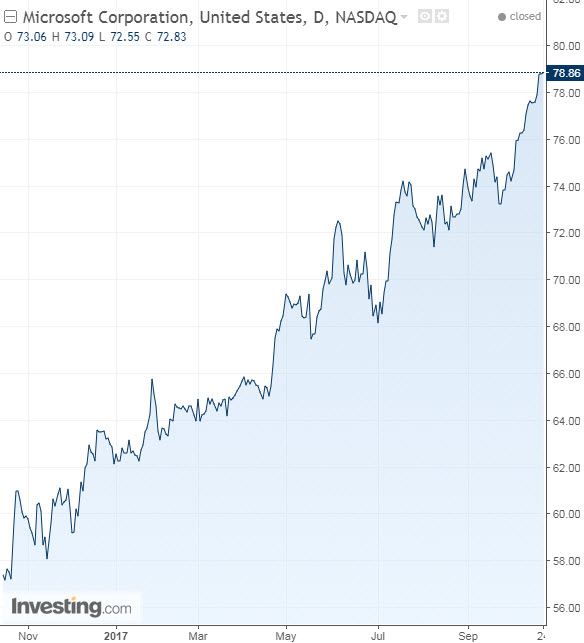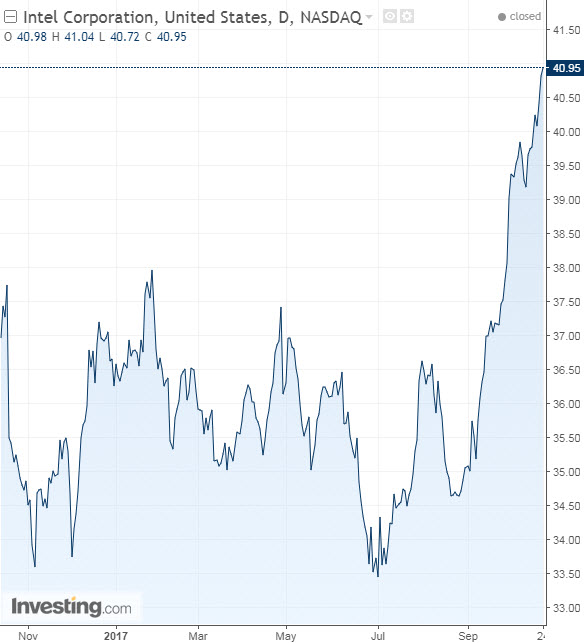by Clement Thibault
What an afternoon it's going to be. Earnings Super Thursday, if you will.
Usually, the big US tech companies manage to spread their report dates over the course of at least two or three weeks, allowing each of these goliaths their own few minutes in the spotlight. This earnings season however, that's not going to be the case. Over the course of a few hours after the US market closes today, we'll see quarterly results from Alphabet (NASDAQ:GOOGL), Amazon (NASDAQ:AMZN), Microsoft (NASDAQ:MSFT), and Intel (NASDAQ:INTC) among others.
It's our view that each of these companies has one specific point of interest we're keeping an eye on in today's reports. For Amazon and Intel it's the competition. Amazon's cloud offering has the entire tech sector nipping at its heels—including Alphabet, Microsoft, and IBM (NYSE:IBM). At the same time, Intel's chips are under attack from Advanced Micro Devices (NASDAQ:AMD), NVIDIA (NASDAQ:NVDA), and Qualcomm (NASDAQ:QCOM).
Alphabet's advertising operation has encountered some speed bumps recently. The record EU fine imposed on the company forced it to change the way shopping ads are displayed and the company has also encountered some backlash about changes to YouTube policies.
Finally, Microsoft's cloud offering, Azure, was supposed to be its next big growth engine. So far, that business segment hasn't been able to jump start the company.
Below, the specific metric to look for in each of the four reports:
Amazon: Web Services Operating Margins

Any savvy Amazon investor is aware that while the company is known for disrupting the retail sector, the real profits come from Amazon Web Services (AWS), the company's cloud offering. Amazon's worldwide retail operation lost money in the last quarter, when a $724 million operating loss in its International Retail division outweighed the $436 million operating profit made in the US.
While AWS is eight times smaller than the retail operation from a revenue perspective ($4 billion to retail's $33 billion), AWS generated $916 million in operating profit. So the math is simple: no AWS = Negative Profitability.
For this reason, AWS's margins are key, particularly now that almost every big tech company has launched a cloud initiative of its own (including Microsoft's Azure, which we cover below).
During Q2 2016, AWS's operating profit was $718 million, from $2.88 billion in revenue. Therefore AWS's operating margin was just under 25%, coming in at 24.9% to be precise.
During Q2 2017, the division brought in $916 million of operating profit, from $4.1 billion in revenue. So last quarter's AWS margin was 22.3% or 2.6% lower than it was in the comparable quarter, undoubtedly the result of growing competition.
Last quarter, Amazon's shareholders were disappointed with its overall bottom line. In the two days following Amazon's earnings report, the stock fell 5.6%, from $1049 to $987. Unquestionably, AWS's operating margins will have a big impact on shareholder reaction to today's report.
Alphabet: Paid Clicks/Cost per Click

Like Amazon, Alphabet is invested in and operates a variety of services. That includes an operating system (Android), a browser (Chrome), and a search engine (Google). However, Alphabet uses a single method—advertising—to monetize all of its businesses.
Last quarter, Alphabet's advertising revenue was a hefty $22.6 billion, out of a total of $26 billion, or 86% of the total. How many clicks a Google ad receives, and how much money is made per click are the two most important factors in evaluating the entire business.
Lately, there's been a worrying trend in Alphabet's quarterly reports. While more people are seeing its ads, and Alphabet is registering significant growth in its number of paid clicks (+52%), it is also seeing a decline in revenue per click (-23%). Both trends are accelerating. Last year, during Q2, the number of clicks generated by ads grew by +28%, but the revenue per click declined by only 6%.
While the number of clicks doubled, the negative growth rate of revenue per click almost quadrupled. As today's report unfolds, this metric will suggest the true rate of growth for the core business of what, truthfully, is the most powerful advertising firm in the world.
Microsoft: Azure's Bottom Line Contribution

Right now there are two main competitors for buzzword of the year: "The Cloud" and "Blockchain." Both are beloved by techies, investors, even the population at large.
Microsoft may not yet be actively involved with blockchain technology, but its version of the cloud, Azure, is critical to its overall business growth. Recent developments in technology are driving more and more individuals and companies to cloud based computing. So just as AWS has become a cash cow for Amazon, Azure should be the same for Microsoft. Only it isn't – or it isn't quite there yet.
Last quarter, Microsoft's Q4, gave us an opportunity to take a look at the company's annual performance. Though Microsoft doesn't release specific figures for Azure, we do know that the venture grew by 99% in revenue over the past year. We also know that revenue for the entire "Intelligent Cloud" operation totaled $27.4 billion for Microsoft, and that it grew by $2.4 billion. So at best, Azure is now a $4.8 billion per-year venture—and that's the best case scenario if all of the cloud growth was spurred solely by Azure, which we know isn't likely. Bottom line: Azure isn't yet justifying all the growth engine hopes and expectations Microsoft has assigned it.
Perhaps more worrying, though Azure's the "Intelligent Cloud" operation revenue grew, its operating income shrank by $200 million. Determining Azure's true role and contribution to Microsoft's future revenues is critical for a variety of reasons, in order to pinpoint its true valuation. We’ll be paying close attention to today's report to see where Microsoft's cloud offering is headed.
Intel: It's All About The Margins

The big story regarding chip makers is competition. With AMD back in the game, and Qualcomm making a push at server chips, the industry is in full competition mode right now.
Competition often spells trouble for companies. And the first red flags are frequently visible via operating margins. Companies will sell products at a lower price, or put more efforts into marketing, or increase their R&D spending—sometimes all of the above—at the expense of lower margins.
Intel's shares are at an all-time high right now because so far it has shown it can keep growing revenue on high margins despite expanding competition. Last quarter, it reported revenue of $14.7 billion, but possibly even more impressive, its operating margins (excluding restructuring charges – such as getting rid of its McAfee, "Intel Security" segment) grew from 20.8% in Q2 2016 to 26.8% in Q2 2017.
The ability to grow operational margins within a highly competitive environment is an impressive feat. In order to remain at its current valuation, or move higher, Intel will have to show it can stay the course on margins regardless of what its competitors are up to.
Conclusion
Amazon's valuation is still sky high (P/E of 246) even as investors are waiting for its bottom line to begin reflecting its current price. Shares will remain above $1000 when and if the bottom line of Amazon's global retail operation returns to green and if AWS margins stabilize around 24%. We're cautious on Amazon stock. Should the bottom line not reflect the share price, the price will shortly reflect the disappointing bottom line.
Alphabet needs to prove that its recent troubles are in the past. The company's stock will stay above $1000 if the growth rate for clicks continues even as the revenue drop per click has been mitigated. We've been bullish on Alphabet for years and our sentiment hasn't changed.
Microsoft shares are on the high side, but will continue heading higher if the operating margins for its "Intelligent Cloud" segment improve, and if Azure keeps growing at a 90%+ rate year-over-year. This could happen, of course, but we believe a negative surprise will do more damage to the stock than a positive revelation would benefit the share price.
Finally, Intel's share price is being bouyed by the high hopes investors have regarding the company's ability to win versus competitors. Another good quarter of growth with steady margins should help Intel reach new all-time highs, if the company can prove any investor concerns are overblown.
